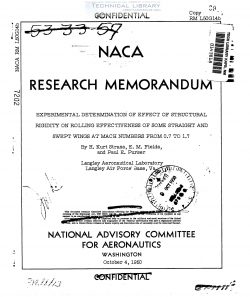naca-rm-l50g14b
- Version
- 90 Downloads
- 1.08 MB File Size
- 1 File Count
- April 26, 2017 Create Date
- April 26, 2017 Last Updated
National Advisory Committee for Aeronautics, Research Memorandum - Experimental Determination of Effect of Structural Rigidity on Rolling Effectiveness of Some Straight and Swept Wings at Mach Numbers from 0.7 to 1.7

The effect of varying the wing structural rigidity on the control
effectiveness of O. 2-chord, plain, ofaired ,ofull— span ailerons on
untapered wing plan forms having 00 and #5 sweep and aspect ratio
of 3. 7 has been investigated by the Langley Pilotless Aircraft Research
Division by utilizing rocket-propelled test vehicles.
The results of the tests indicate no radical differences between
straight and swept wings in the changes in rolling effectiveness due
to changes in structural rigidity.
The test results compare favorably with results obtained by use of
existing methods of estimating the effects of structural rigidity on
rolling effectiveness for unswept wings (NACA Rep. 799 and NASA TN 1890)
at subsonic and supersonic speeds. As an illustration of the use of the
experimental data, they have been analyzed by the method of NACA Rep. 799
to provide approximate twisting-moment coefficients for an extension of '
that method to transonic speeds and swept wings.
The problem of estimating the rolling power of controls on flexible
wings continually faces the designer. Relatively simple methods for
making such estimations for unswept wings at both subsonic and super—
sonic speeds have been advanced in references 1 to 6. The present
investigation was undertaken to provide a check on these methods in
the speed range where existing aerodynamic theories are applicable and
to obtain data at transonic speeds in order to offer some guide to the
designers now interested in aircraft which are to fly near a Mach number
of l.
All of the wings tested were untapered with an aspect ratio of 3.7
and employed full-span plain ailerons. Information was_pbtained for
six values of structural rigidity on unswept wings and five values of
structural rigidity on wings swept back #50. All of the foregoing
wings employed the NACA 65AOO9 airfoil section parallel to the model
center line. In addition, two values of structural rigidity were inves-
tigated for unswept wings which employed the NACA 65AOO3 airfoil section.
The structural rigidity, referred to as "torsional rigidity" throughout
this paper, is the usual torsional rigidity for unswept wings. For
swept wings, however, the torsional rigidity used herein was derived
from torques applied and twists measured in planes parallel to the model
center line and thus includes both bending and torsional stiffness as g
usually defined.
| File | Action |
|---|---|
| naca-rm-l50g14b Experimental Determination of Effect of Structural Rigidity on Rolling Effectiveness of Some Straight and Swept Wings at Mach Numbers from 0.7 to 1.7.pdf | Download |

Comment On This Post